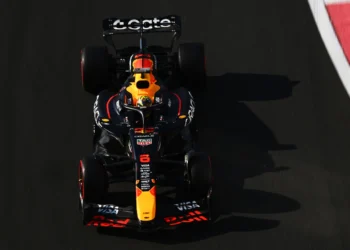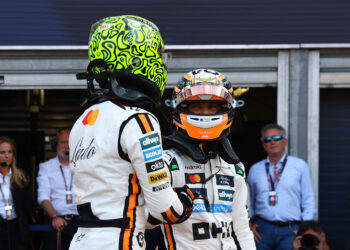McLaren’s Team Principal, Andrea Stella, has shed light on the problematic brake failure experienced by Lando Norris during the Formula 1 Chinese Grand Prix, a mishap he labeled as “unacceptable.” Norris, behind the wheel of the MCL39, faced this challenge while being a consistent second-place runner throughout the race held at the Shanghai International Circuit.
Norris was tailing Oscar Piastri, his teammate at McLaren, and the ultimate victor of the Grand Prix, for most of the race. However, the final stages of the race saw Norris continually checking his rear-view mirrors as he grappled with an elongating brake pedal, a situation that could have prematurely ended his race.
Despite the self-branded “nightmare” scenario, Norris adeptly navigated the issue. Nevertheless, his seven-second lead over third-placer George Russell dwindled to a mere 1.3 seconds by the time the race concluded, thereby dashing any chances he had of overtaking Piastri for the top spot on the podium.
While Stella expressed satisfaction with McLaren securing its 50th one-two finish – a significant milestone in the team’s history – he expressed dissatisfaction with the brake failure that plagued Norris’s performance. “We are pleased with the one-two finish, but the brake pedal failure on Lando’s car, which we had to manage for the last twenty laps, is a matter of concern,” Stella voiced.
He went on to commend Norris and the team for their management of the situation, including adapting their driving style to accommodate the problem. However, he acknowledged that the issue was severe enough to potentially jeopardize the result, an occurrence he deemed “unacceptable” from a reliability standpoint. “We must strive to improve,” Stella added.
The Team Principal proceeded to offer a limited explanation of the problem, citing IP reasons for not disclosing the full details. He hinted at the issue being linked to a leak in one of the components, not associated with the brake line, but elsewhere. The primary response required was to restrict peak brake pressure, he added.
The latter stages of the Chinese Grand Prix saw Norris grappling with a ‘nightmare’ brake issue. Stella elaborated on how Norris had to modify his driving style to cope with the brake pedal situation. “Lando could still brake, but he had to do so very gently,” Stella explained.
What was initially a 100-metre braking distance gradually increased to 200 metres, and then 300 metres, because Norris had to decelerate, coast to a certain speed, and then apply very gentle brake pressure. This strategy was crucial to prevent the leak from escalating rapidly.
“As the brake pedal kept extending, we had to ensure that the peak pressure was minimized. Consequently, Lando had to brake with decreasing peak pressure,” Stella explained. This situation reached a crescendo during the final laps when Norris had to coast for a significant duration, off-throttle, and then apply minimal brake pressure to navigate corners.
The Chinese Grand Prix served as a harsh reminder for McLaren and Norris about the criticality of vehicle reliability in the world of high-stakes Formula 1 racing.










